River Pinheiros BOD, P Removal and DO Supplementation
With less than satisfactory environmental management of disparate effluents we find some waterways contaminated with domestic sewage, resulting from rapid population growth and close population of the marginal areas of reservoirs. The scarcity and increased consumption of water free of contamination increases the need for developing technologies for water treatment and proper management of available water resources. Alternatives for the treatment of polluted and contaminated waters need be developed an hence the need to improve processes, enhance operations and reduce costs for remediation of water bodies. On the initiative of the Secretariat of Environment of the State of São Paulo the opportunity to present new technologies for environmental improvement evaluation using the river Pinheiros, a heavily polluted and foul smelling stretch, presented itself.
Amongst the new technologies in bioremediation, the use of hybrid enzymes and bacteria had been tried, those attempts have shown inconsistent results and mostly temporary results todate. The potential to change and strengthen the metabolism of native bacteria, with products that are non-toxic and environmentally compatible , has been the subject of continued research in the scientific community. Evidentially it has been shown that the metabolism of bacteria can be altered to significantly impact the increase in respiration and nutrient uptake, converting much of this energy into carbon dioxide instead of increased biomass. The metabolism of the microorganisms responsible for the degradation of organic matter and other contaminants in the treatment of sewage and industrial effluents has been optimized by applying a product registered with IBAMA under the category of Environmental remediation biostimulator. This formulation is now recognized as FGX3, composed of proteins from the yeast fermentation, with surfactants and adjuvants. The development of biostimulator FGX3 is assists in the treatment of various types of contaminated water though additional testing on a small scale was necessary for the fulfillment of removal of organic matter and nutrients to a satisfactory conclusion when applied directly to water bodies. To prove its capacity to improve environmental conditions, the FGX3 product was applied at the purpose built facilities at EMAE canal, next to “Treason” pumping station to demonstrate the effectiveness of biostimulator FGX3 as an adjuvant treatment of Canal waters of Pine and its surroundings.
Introduction
Reported is a test conducted with the waters of the Pinheiros River, in an experimental channel that simulated the conditions of Upper Pine River March, 2013 , using the biostimulator FGX3 in order to demonstrate :
- Service quality standards Class 4 , CONAMA Resolution 357/2005
- Improvements to the visual aspect of the waters of River Pines
- Increase the dissolved oxygen available in the water environment
- Reduction of the presence of oil and grease
- Improvement in turbidity
- Elimination of foul odor
- Efficient removal of organic matter
- Reduction of suspended solids
The FGX3 environmental remediation is a liquid , without the presence of viable microorganisms containing only a combination of proteins of low molecular weight extracted from the yeast Saccharomyces cerevisiae with small amounts of surfactants and adjuvants.
The test was performed with the concentration of 3mg / L biostimulator added FGX3 and aeration of the experimental points in two channels.
General Description of the Test
This test was conducted in the area serviced by EMAE (Empresa Metropolitana de Aguas e Energia SA) at the Pumping station of Treason in 2013. EMAE constructed six experimental channels, each 30 meters long and with input flow of 104.2 L / h , which received water pumped from River Pines near the test area.
The input flow simulated hydraulic detention time of the Pinheiros River to achieve as near as possible conditions similar to those of the Pinheiros River and facilitated tests with differing technologies that could help improve the pollution of waters of the Rio.
Test were run over a 30 day period.
The effluent was discharged into the lower canal collector sewer system of the Sanitation Company of the State of São Paulo – SABESP.
The other channels were operated by four other competing companies, and the number 2 channel was the independent control , so that it could serve as the “white” channel.

Figure 1: Aerial photo of the experimental channels
Materials & Methods: Overview of the experimental channel and equipment
Table 1 : Construction characteristics of the channel tests with no top enclosure intended to mimic the river conditions
| Width (W) |
1.0m |
| Length (C) |
30.0m |
| Total height (H) |
0.6m |
| Net blade height (h) |
0.4m |
The experimental channels received feed water from the Pinheiros River, pumped to a glass fibre holding tank with a volume of 0.320 m³ . The distribution trial was conducted by channel PVC tubing and controlled and regulated by EMAE throughout the 30 days. The experimental simulation channel was divided for control and analysis of parameters at 7 location points:
- Point 1 : Arrive – 0 meters
- Point 2 : 5 meters
- Point 3 : 10 meters
- Point 4 : 15 meters
- Point 5 : 20 meters
- Point 6 : 25 meters
- Point 7 : Output – 30 meters
To enable a reasonable assessment of the effectiveness of the applied technologies there was a requirement for at least 15 days of data collection and analysis at the seven points along the canal with repeatable parameters .

Figure 3: Photo of Channel test
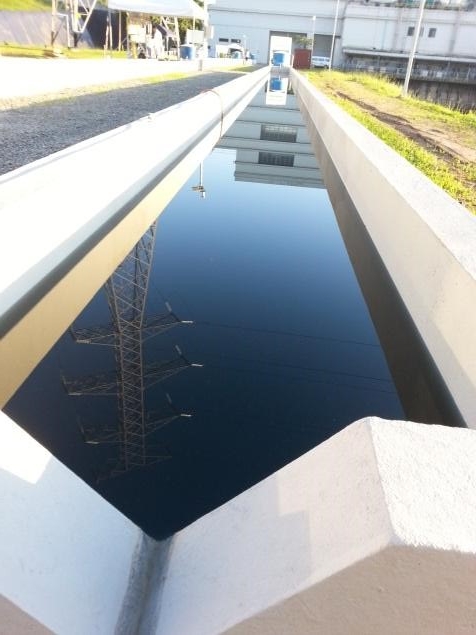
Figure 4: Picture of output channel tests
Materials & Methods: Air Diffusers
Two tubular fine bubble diffusers of 60 mm diameter and 600 mm length were installed (as shown in figure 2), with maximum air flow of 0,110 m³ / min at two points of the experimental channel, approximately 3 meters and 13 meters from the channel inlet. Air flow supplying the diffusers was controlled with a flow meter which indicated the total flow of air delivered in the system.
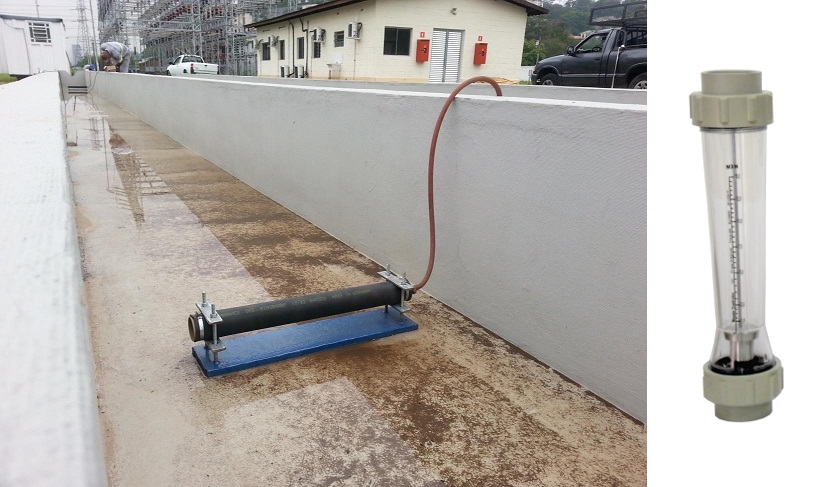
Figure 2: Air Diffuser fine bubble
Materials & Methods: Reverse Osmosis Filter
For this test because the dose of FGX3 is very low and the amount of product volume dosed very small a daily FGX3 dilution in distilled water produced using a reverse osmosis filter, in order to obtain a dosing solution of FGX3 without impurities clearly at higher flow applications there is no need to dilute the FGX3 product.
Materials & Methods: Metering Pump
FGX3 Solution dosing was controlled in the experimental entry channel through metering pump that continuously operated at a flow rate of 5.2 ml / min.
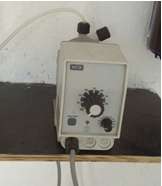
Figure 3: Metering pump
Operational Phase
Experimental channels operated at ambient temperature and at a constant flow rate of 104.2 l / h, which was continuously dosed 5.2 mL / min of a solution of FGX3 diluted 1:1000 so that the concentration of 3mg/l formulation was reached throughout the whole channel. Also, in the experimental channel (3 meters and 13 meters), aeration by diffused air was performed to produce faster results because of the short retention time, for this purpose, two diffusers were used and each operated at ¼ of its total capacity. Monitoring commenced 10 days into the experiment and again after 15 days of adaptation of FGX3, seven points of the experimental channel were recorded: input, every 5 meters and output. pH, temperature, dissolved oxygen (DO), conductivity and turbidity. Besides these parameters , at entry , 15 meters and output, samples were collected for additional parameters: Total Solids, Volatile Suspended Solids, Total Suspended Solids, Settled (sediment) Solids, Phosphorus, Total Organic Carbon, Total Nitrogen, Nitrogen ammonia, nitrite, nitrate, Escherichia coli, Surfactant, and sulfide toxicity (Microtox). At the end of thirty days, assessment of the level of siltation of the canal was performed using analysis of total solids (TS). With the results averaged and the area of the experimental channel known the results were used to calculate the amount of solids that remained in the system. All analyses were performed by accredited laboratory.
The experimental channel allowed the simulation of various aspects related to the flow of the Pinheiros River enabling deductions to be made about the potential beneficial effects of biostimulator FGX3 over the polluted waters of the river.
Results
The dimensions of the experimental channel, as described in Materials & Methods: Overview of the experimental channel & equipment, allowed results to be correlated to a travel time of approximately 4.8 days.
Among the basic parameters, the temperature of the water is one of the most important characteristics of the aquatic medium and plays an important role in the control of the parameters monitored and, in the FGX3 experimental channel an average temperature of 23.5 ° C was maintained which is ideal for maintenance of aquatic life in the river corridor.
With respect to pH, the results in the range from 7.51 to 7.81, were in the optimal range required in Article 17, Item VII, CONAMA 357 for Class 4 rivers of pH 6.0 to pH 9.
The water collected from the Pinheiros River used to feed into the experimental channels, showed dissolved oxygen (DO) near 0 mg/l in almost every test period, rising to 1.00 mg/l only twice.
The requirement for OD of Article 17 of CONAMA Resolution 357, for rivers with Class 4 is the maintenance of 2.0 mg/l over the entire length of the river.
With the application of FGX3 on channel 3 an average of 5.00 mg/l of DO resulted not only in compliance with the legislation but reaching an increase of over 200 % above the regulatory requirement. Figure 4 illustrates the comparison of the effluent inlet 15 m (intermediate) and effluent output required by CONAMA. Further, throughout the test period, it was found that the OD was above the level recommended by law, as illustrated in Figure 11.
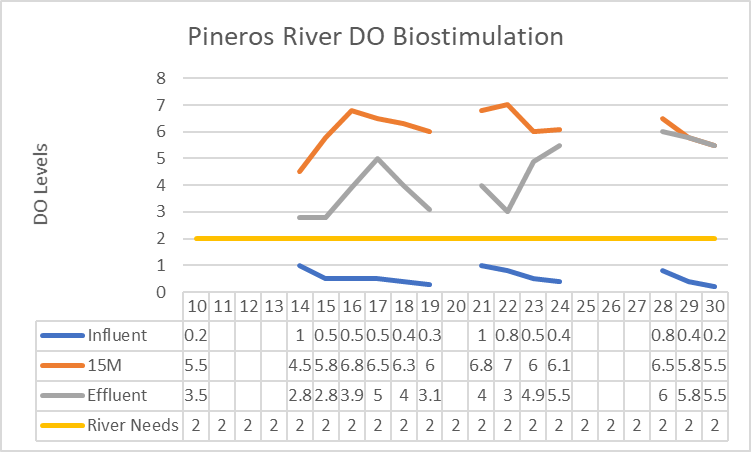
Figure 4: Chart series for dissolved oxygen throughout the test period
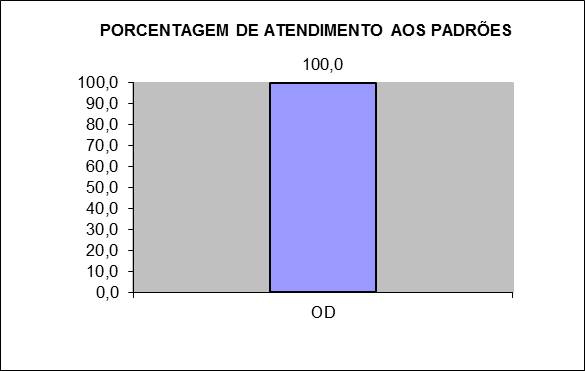
Figure 5: Percentage of service to standards
For other parameters, described in Table 2, we present the results also in boxplot. This type of representation shown in the box, the median (50%), the top quartile (25%) and third quartile (75%). Moreover, they are discriminated percentiles 90%, 75%, 50% (median), 25% and 10%, and displayed the lowest and highest scores through the lower and upper limit of vertical straight lines, which originate from the first and third quartiles, respectively. For this type of presentation is correct to say that the greater the length of the inner box will be greater the heterogeneity of the sample and the higher the standard deviation.
For the box plot of conductivity parameter, we can observe a slight drop in conductivity without large variations, as shown in Figure 6.
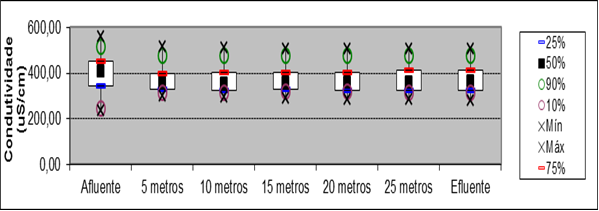
Figure 6: Box plot for the parameter Conductivity at all points of the experimental channel
The Box plots shown in Figures 7 and 8 show the results obtained by applying FGX3 for Suspended solids and Volatile Suspended Solids, respectively, which showed good ability to remove solids, reaching a reduction of 70.87% and 43.54 %, respectively, resulted in low turbidity appears during the test period
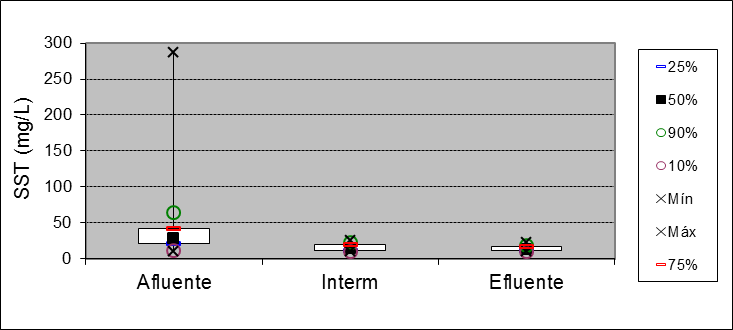
Figure 7: Box plot for SST parameter at entry points 15 meters and output
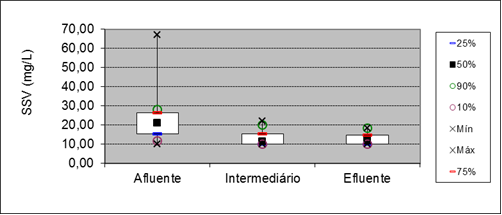
Figure 8: Box plot for parameter SSV at points of entry, and 15 meters out
As for the Totals and sedimentable solids despite the reduction, there were no significant changes.
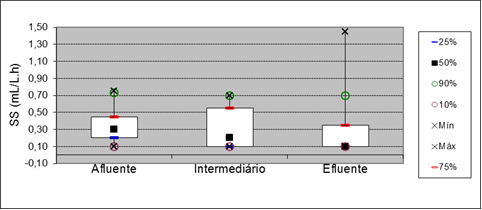
Figure 9: Box plot for parameter ST at points of entry, and 15 meters out
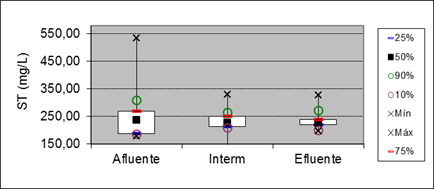
Figure 10: Box plot for the parameter SS at points of entry, and 15 meters out
Analysis of Total Organic Carbon (TOC) is a measure of water quality for evaluation of water contamination with organic impurities. With the application of FGX3 to the polluted waters of the Pinheiros River, we observed a reduction of 54.7% as boxplot shown in Figure 11.
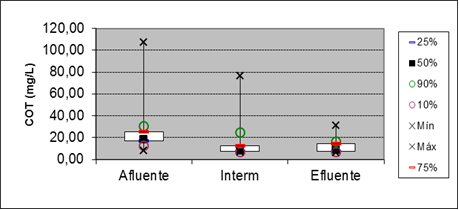
Figure 11: Box plot for TOC parameter at entry points 15 meters and output
In Figure 12, it is possible to evaluate the results boxplot of phosphorus, which observes an early change of the experimental results in the inlet channel of 17% before stabilizing at 1 mg/l
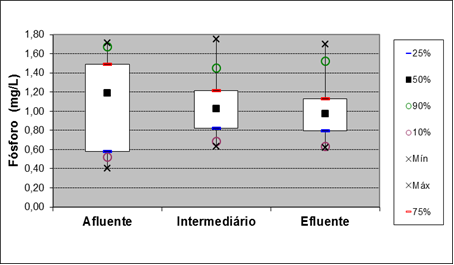
Figure 12: Box plot for parameter match the points of entry, and 15 meters out
Bacterial pollution of Escherichia coli displayed high variability in the effluent from the entry point continuing along the channel to the 15M sampling point.
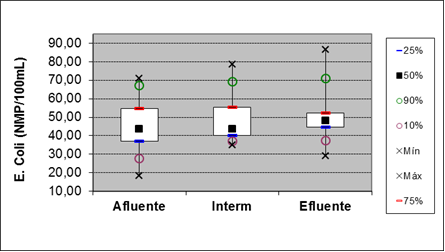
Figure 13: Box plot for the parameter of E.coli at points of entry, and 15 meters out
The application of FGX3 in the experimental channel in the effluent delivered a final reduction of 95.21% of sulfide concentration compared to the influent level of the Pinheiros River. This large reduction of sulfide was evident 15 meters in and compared to the control this was also reflected in the absence of odour throughout the FGX3 dosed system at the three observation points. This reduction can be seen in boxplot of figure 14.
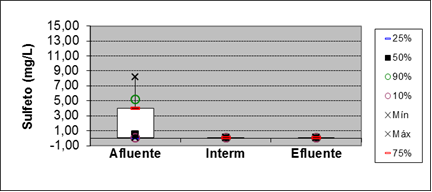
Figure 14: Box plot for the parameter Sulfide at points of entry, and 15 meters out
Surfactants have been, on some days, at high concentrations in the influent from the Pinheiros River, observed at the entry point of the experimental channel, however, throughout the channels and at the effluent point there were low levels with minimal variation.
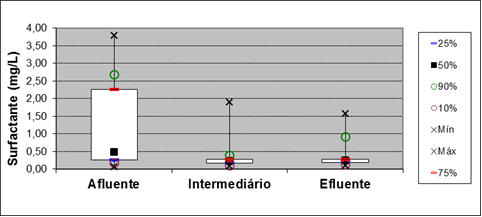
Figure 15: Box plot for parameter Surfactant at points of entry, and 15 meters out
The experimental channel influent from the Pinheiros River had a high concentration of ammonia nitrogen, indicative of the water contamination. With the application of FGX3, we observed a significant reduction in the concentration of Ammoniacal Nitrogen, being converted to NO2 (nitrite) and NO3 (nitrate) as boxplots presented in Figures 16, 17 and 18. Presenting a 58.40% efficiency in the oxidation of ammonia.
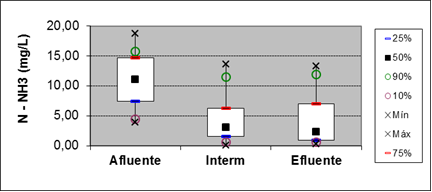
Figure 16: Boxplot for the parameter of ammoniacal nitrogen at points of entry, 15 meters and output
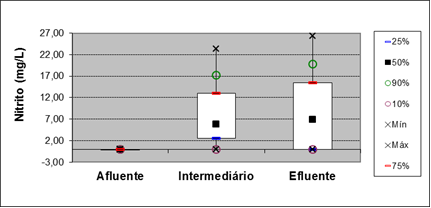
Figure 17: Boxplot for the parameter of Nitrite at points of entry, 15 meters and output
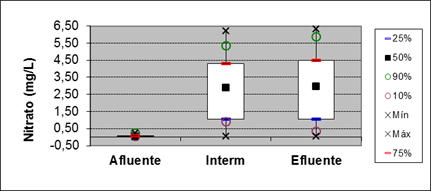
Figure 18: Boxplot for the parameter of nitrate at points of entry, 15 meters and output
As expected, when applying FGX3 in the effluent of the Pinheiros River, which was already regarded as environmentally toxic, there has been no detrimental change in toxicity since FGX3 is a product free of toxic substances, which may affect the microorganisms present in the waters of the river Pinheiros. This observation can be found in table 3 that presents the results of Ec50 for the incoming effluent, 15 meters and output.
Table 3: average results of toxicity for the Influent points, intermediate and final effluent
Acute toxicity in Vibrio Fischeri (Microtox)
| Collection points | Ec50;15 min (%) |
| Input (0 metres) | 24.15 |
| Intermediate (15 metres) | 50.18 |
| Output (30 metres) | 57.95 |
Higher values of the Ec50, signifies decreasing toxicity of the effluent to the micro-organism. It appears, then, that the FGX3 confers no toxicity to effluent and is not detrimental to the aquatic life of the river.
As requested by the SMA, after completion of the test, analysis of siltation level in experimental channel through the analysis of total solids was carried out with the re-suspension of solids from the bottom, on the day following the last day of testing. After suspension and homogenization of solids from the bottom sediment, were obtained the results presented in table 4.
Table 4: Results of total solids after suspension of solids in the background
Values of total solids in mg/L-10/22/2013 collection of the 12 m3 channels at 30M length
| Sample Point | Total solids mg/l | Solids Statistics |
| 5m | 442 | 342.25 g/m3 |
| 15m | 350 | Total = 4107 gm |
| 20m | 300 | Calculated depth=0.1369 mm |
| 25m | 277 | |
| 30m | 342.25 |
Therefore, at the culmination of the test period treatment of FGX3 only increased sediment depth by 0.1369 mm extension.
Conclusion
After applying FGX3 the following improvements were evidenced:
- Dissolved oxygen with an average of 5.0 mg/L throughout channel
- Reduction of 95.21% sulfide
- Complete absence of odour
- Reduction of Total and volatile suspended solids of 70.87% and 43.54%, respectively
- Nearly 70% reduction in effluent turbidity;
- Low potential for siltation
- Efficiency in conversion of ammoniacal nitrogen at around 58%
- Increase in the degradation of organic matter around 55%;
The CONAMA resolution 357 for class 4 rivers was fully satisfied with the application of FGX3 in the waters of the river Pinheiros, achieving 100% of time spent that the dissolved oxygen remained above the standard required. There was complete absence of odour in the early meters after applying FGX3, reflected in the significant reduction in sulfide levels in the samples. Excluding the presence of bad odour, low potential for siltation, the significant reduction in the concentration of solids and the very low turbidity verified after applying the FGX3 is a fully assured outcome for the Pinheiros River restoring navigation and landscape harmony, an expected resultant for the rivers of class 4, in section I, item V of CONAMA resolution 357.
Furthermore, other noticeable improvements after applying the FGX3 were the significant reductions in the concentration of nitrogen, indicating a lowered potential for eutrophication. Importantly, in addition, the application of FGX3 has reduced the concentration of organic carbon present in the waters of the Pinheiros River, delivering the largest organic matter degradation and accompanying significant improvement in the quality of the waters of the river Pinheiros.
